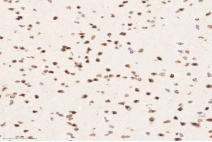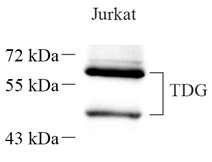| Reactivity: | H & M,R |
| Applications: | WB & IHC |
| Host Species: | Rabbit |
| Clonality: | Polyclonal |
| Full Name: | TDG rabbit polyclonal |
Gene Name: | G/T mismatch-specific thymine DNA glycosylase |
Synonyms: | TDG, thymine DNA glycosylase, C-JUN leucine zipper interactive protein JZA-3, JZA 3, Jza1, EC 3.2.2.29 |
Immunogen: | Recombinant protein corresponding to Mouse TDG |
Isotype: | IgG |
Purity: | Affinity purification |
Subcellular location: | Nucleus |
Predicted MW. | 47 kDa |
Observed MW. | 47/60 kDa |
Uniprot ID: |
Product Usage Information
Applications | Species | Dilution | Positive tissue |
WB | Human | 1: 500-1: 1000 | Jurkat |
IHC | Mouse, Rat | 1: 6000-1: 12000 | brain |
Background
TDG belongs to the TDG/mug DNA glycosylase family. TDG corrects G/T mispairs to G/C pairs. It is capable of hydrolyzing the carbon-nitrogen bond between the sugar-phosphate backbone of the DNA and a mispaired thymine. In addition to the G/T, it can remove thymine also from C/T and T/T mispairs in the order G/T >> C/T > T/T. It has no detectable activity on apyrimidinic sites and does not catalyze the removal of thymine from A/T pairs or from single-stranded DNA. It can also remove uracil and 5-bromouracil from mispairs with guanine. RNF4 interacts with and requires the base excision repair enzymes TDG and APE1 for active demethylation . TDG is modified by SUMO-1 and SUMO-2/3.The molecular weight of non-modified TDG is 46 kDa and modified TDG is 55-60 kDa.
Images
| Western blot analysis of TDG (GB113186) at dilution of 1: 1000 Lane 1: Jurkat cell lysate |
 | Immunohistochemistry analysis of paraffin-embedded mouse brain using TDG (GB113186) at dilution of 1: 12000 |
 | Immunohistochemistry analysis of paraffin-embedded rat brain using TDG (GB113186) at dilution of 1: 12000 |
Storage
| Storage | Store at -20°C for one year. Avoid repeated freeze/thaw cycles. |
| Storage Buffer | PBS with 0.02%sodium azide,100 μg/ml BSA and 50% glycerol. |




